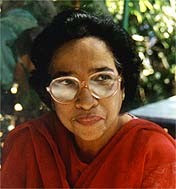On the west coast of India about 8-10 kms from the port city Mangalore, is a small town called Ullal. Situated on the south bank of the Nethravathy River, it has a scenic coastline along the Arabian Sea. Huge black rocks and treacherous breakers make some parts of the beach unsafe for swimming. But the shady stretches of causarina groves and miles of golden sand make it an ideal place for a holiday.
Way back in the 16th century, Ullal was a small port exporting spices and black pepper. Being a rich and popular trading centre, it was coveted by the Portuguese, British and Dutch. But for almost four decades a young queen called Abbakka, successfully repulsed these intruders, making them beat a hasty retreat. Her main enemy was the Portuguese who tried to capture Ullal on many occasions between 1558 and 1618, by land and by sea. Abbakka had a well trained army drawn from all castes and religions. The Mogaveeras (fisher folk) were sturdy and fearless men who formed the backbone of her army.
In 1568, Portuguese General Joao Peixoto managed to enter her royal court with his men. But Abbakka fled and took shelter in a mosque close by. Here she banded together 200 of her best soldiers and went back to face the enemy. Peixoto and several of his men were killed, and many others taken captive.
Abbakka belonged to the Chowta Dynasty which ruled a part of South Kanara, from the temple town of Moodabidri to Ullal. She had a dusky complexion with sharp attractive features, and though short, carried herself with great dignity. The Chowtas followed the matrilineal system of inheritance. So female members became leaders. Abbakka’s uncle Tirumala Raya trained her in warfare, sword fighting and archery. She was supposed to be the last person who used the fire arrow (Agni Vana) in warfare. She was also an accomplished horse rider.
Tirumala Raya trained her to be a good administrator and business woman. At the age of 15, he made her the Queen of Ullal. But her marriage alliance with Lakkaya the Banga Prince of Mangalore, was disastrous. He was a lackey of the Portuguese, and willingly paid taxes to them hoping to remain in their favour. Abbakka refused to be subservient or to pay taxes to a foreign power. She spurned their terms of trade and preferred to ship commodities directly to the Middle East. Her attitude caused much friction between the couple and she separated from him, returning to Ullal to resume her royal duties.
Even though Abbakka was a queen, she was very simple and always dressed in a cotton sari, with a cloth covering her mouth and upper torso. Her umbrella was made of areca palms. She was also a caring queen who had the best interests of her subjects at heart. She dispensed justice to her people, often working late into the nights.
Abbakka was an astute statesman. She forged alliances with the Zamorin of Calicut, the Sultan of Bijapur Ahmed Nazar, and several Muslim chieftains. Her last war against the Portuguese was in 1618. In the war, she was represented by a General from the Zamorin’s army. Though he was able to capture the Mangalore Fort, he was killed on his way back to Ullal. Abbakka was arrested and jailed soon after. But she revolted and died fighting. She was the first female freedom fighter of India against Colonial powers.
Abbakka belonged to the Jain sect which is so non-violent that it prohibits killing even of an insect. But she had no qualms about vanquishing her enemies through warfare.
After one of the Portuguese defeats, the Emperor of Spain reprimanded his Portuguese commander,
“Are you not ashamed of being defeated again by a black, dwarfish Indian woman named Abbakka? Though she is our enemy, I have great admiration for this heroic woman. Tell me something about her.”
It was the Persian Emperor Shiya Abbas who advised Peitro Della Valle an Italian traveller, to interview Abbakka. “When you go to India, please go to Mangalore without fail. There is a pepper queen named Abbakka, who is the talk of Europe for her victories over the Portuguese. Don’t miss to meet that woman.”
Yet in her own country she was forgotten for centuries, and only remembered in folklore and field dramas. Of late, there has been a resurgence of interest in her. In 2003, the Postal Department issued a stamp to honour her. Bronze statues have been erected in Bangalore and Ullal. There she sits in all her splendour astride a horse, mounted on a high platform at the Abbakka Devi Circle.
Since 1998, the Veera Rani Abbakka Utsava is held annually, when distinguished women are honoured. There is talk of a film on her life in the making.
Visitors to Ullal can see the Somanatheshwar Temple built by the Queen and the remains of her Fort in the vicinity of the temple. The Rudra Rocks (Rudra Shila) close by, is a sight to behold, as it keeps changing colour because of the relentless pounding of the waves. Ullal is well connected by road or train, and a lovely weekend get-away.
Monday, October 11, 2010
Subscribe to:
Posts (Atom)






